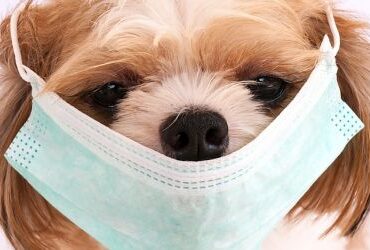
Fall Allergies
Hi everyone, and thanks for joining me on this edition of Val Talk’s Pets. In this edition, I am going to talk about fall allergies. The rise in pet parents […]
 play_arrow
play_arrow
Canine Herbalism – An Interview With Rita Hogan Val Cairney

 play_arrow
play_arrow
The Shoulds of dog parenthood Val Cairney

Hi everyone, and thanks for joining me on this episode of Val Talk’s Pets. Well just like I discussed in Cats, there are a lot of questions that begin with the word “Should”. That’s always a bit of a weird way to start a question, but let’s explore the top 5 Shoulds of dog parenthood.
Good question! Well, according to VCA Animal Hospitals, “A healthy dog may have a warm, dry nose after a nap, or after extreme physical exertion associated with dehydration. Some dogs develop a chapped, dry nose as they age or after exposure to the elements (like) extreme wind or sun. Dry noses aren’t always a sign of trouble.”
When it comes to noses, whether a dog’s nose is wet or dry is quite individual. It is recommended to become accustomed to what is normal for your dog. A wet nose is normal. According to Petmd.com, like humans, dogs have fluids and secretions from their noses as well. “This liquid wicks out to the nose surface, evaporates, and then helps to cool the dog.” We know that dogs can only sweat through their nose and paws, so this cooling mechanism makes sense.

Dogs also lick their noses. Because dogs explore with their noses, they get stuff on their nose. Dirt, dust etc. sticks to their nose so they lick it and therefore, their nose is moist. Also, according to bondvet.com, “a wet nose is better for a dog’s sense of smell since scent particles stick to a moist nose.”
Now these particles and interesting smells that a dog gets on their nose go through another transport. “By licking their nose, a dog transfers those scent particles to the roof of the mouth, where they are detected by the vomeronasal (vom-er-on-nasal) organ. Also known as Jacobson’s organ, this specialized structure “reads” scents and chemicals such as pheromones.” And dogs also simply lick their nose to keep it clean.
As for a dog’s health being indicated by a wet or cold nose, it is not an accurate barometer. If the nose is constantly running or has a discharge, this could indicate something is going on.
As for a dry nose, this can be quite normal too. Again, we have to know the “normal” for your dog. Older dogs often have a drier nose and some breeds like brachycephalic dogs, like pugs will often have dry noses. Other things contribute to a dog having a dry nose. According to bondvet.com, a dog waking up from a nap can have a dry nose.
Where the dog lives contributes as well. If you live in an area where the weather changes to winter and your house has a furnace on, a dog’s nose can easily become dry especially if they nap by the heat vent. Warm and windy weather can also contribute. And those beautiful sunny days can expose a dog’s nose to sunburn contributing to a dry nose.
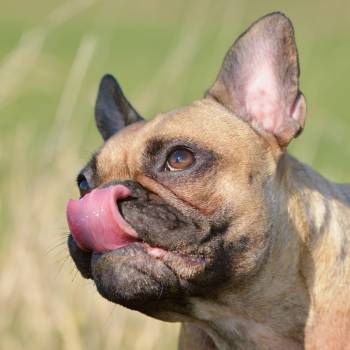
Sometimes a dry nose according to bondvet.com, can be a sign to be concerned. If the dog is incessantly licking their nose, this could indicate a feeling of being unwell or dehydrated. But, the behaviour would have to be pretty noticeable to chalk up the dry nose to a health issue.
Some dogs just have a dryer nose, especially if they are older. Some really good natural nose balms on the market can help a dog with a dry nose.
When it comes to the noses of a dog, the idea is to be familiar with what is the norm for your dog. Any deviations from that, in a significant form, like bleeding or running excessively accompanied by other unwell symptoms means something is going on.
But, should my dog’s nose be wet or dry depends on your dog but generally, neither one indicates a health issue.
Another interesting question. I often see dogs having a spa treatment online and their paws are given a rub of some kind of emollient balm, rubbed in with love and care by the parent. I have often wondered about this too. Shouldn’t the dog’s paw pads be somewhat rough? I mean, aren’t the pads supposed to be like shoes? It is recommended that a healthy dog paw should be smooth. According to PetLab.Co.com, a healthy paw pad, “will be smooth to the touch with no signs of excessive dryness, cracking or cuts.”
I don’t think in any way a dog’s pad is going to be as smooth as the palm of your hand, because as stated, they walk around on pavement, rocks, grass, dirt, you name it. But, the idea that the pad should not have cracks and cuts is something to look out for.

Yes. Some very nice natural balms are dog-lick-friendly and can be rubbed into a dog’s paw if the pad is too rough and may crack because of excessive dryness.
And speaking of paws, so many dog parents want to protect their dog’s paws in the winter, not just from snow, ice and salt, but also from the cold. The truth behind boots for dogs is that they are very difficult. They are difficult to get on the dog and have them stay on the dog.
I have a set of boots for Tundra that have a good tread and a special type of Velcro that will not stick to fur and they stay on and keep his feet protected in the winter. The drawback? They were very expensive. When a dog parent comes in and says they are looking for “booties” for their dog, I cringe. First, these are a garment for a dog for paw safety.
The idea that they are cute little booties, is not the reality. Secondly, 4 out of 5 dogs will have those boots off in seconds, or make your life torture trying to get them on. And, when you go to the store for boots, bring the dog or measure the dog’s paw. Have your dog stand on a piece of paper and draw a circle around the paw. Bring this with you.
When the conversation goes from, I would like boots (booties) for my dog. Do you know their size? No. Did you measure their paw, no. Has your dog worn boots before? No. We are not going to be successful in this transaction, I can tell you.
So, should my dog’s paws be rough? Not really. They should be smooth to the touch but not overly soft and not dry, cracked or cut.
Well, this is an interesting question. How many dog parents see their dog eating grass and not shortly later, see them throwing up? I have dealt with this question before in one of my other episodes, but let’s review. Why do dogs eat grass? It is a bit of a round robin in that we cannot tell if the dog is eating grass because their stomach is upset or they upset their stomach because they ate grass.
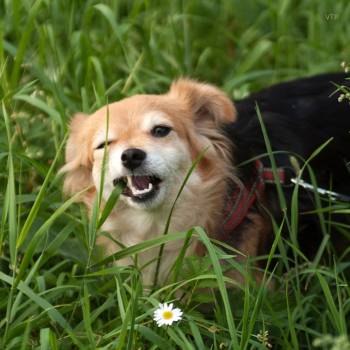
According to VCA Animal Hospitals, dogs that eat grass may be trying to up their roughage to help with digestion. If this is the case, it is warranted to look at the quality of the food the dog is being fed, as they are seeking nutrients, vitamins or minerals that they are not getting in enough levels for their system. Now, just to add on here, some dog parents observe that even if they feed very high-quality food, the dog will still eat grass.
What I surmise here is that the dog may be just not assimilating a certain vitamin or mineral. This doesn’t mean the food is insufficient, it just means that the system with that particular dog does not assimilate fully a certain vitamin or mineral. In this case, the dog forages looking to increase the intake. I would add a multivitamin to this particular dog’s diet to begin with, to see if the grass eating decreased.
Another reason a dog may graze on grass, according to VCA is basically to do something while hanging around outside. It is rather fun to forage around eating grass and they may simply just like the texture and taste of grass.
The problem, however, with grass eating, is that the grass would have to be 100% free of chemicals or turf supplements. Also, grass could easily have parasites hidden at the bottom and if the dog snatches the grass pretty low, they could be ingesting these parasites.
Should dogs eat grass? Not really, but overall it isn’t dangerous, but it could be depending on the grass and if they are throwing up they should not be eating grass.
We saw this question with the “should” questions for cats. A lot of the recommendations for whether to use a raised bowl or diner are the same as for cats. If the dog is senior or has a neck or back problem, a raised bowl or diner is a good idea. But, overall it is not necessary.” Hmm? We have a raised diner for Tundra as he is a big dog. According to basispet.com, “there appears to be no scientific data that supports any medical benefits from elevated bowls.”
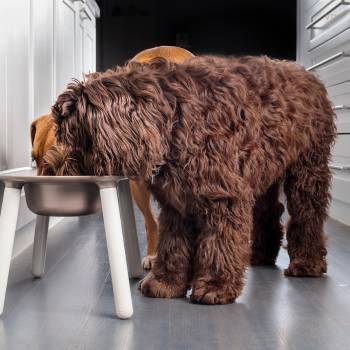
As I said, we use an elevated diner, but according to Whole-Dog-Journal.com, “Large and giant-breed dogs who eat from an elevated feeder have an increased risk of developing gastric dilation and GDV, also known as bloat and turning of the stomach.” The research through many sources takes a strong stand that elevated diners are not beneficial to any dog, and not big dogs.
Well, I did a bit more digging and according to the abstract from a paper posted with Veterinary Evidence.org, named, Are dogs that are fed from a raised bowl at an increased risk of Gastric Dilation Volvulos (Val –vu-lus) compared with floor-fed dogs(?), “no studies found that feeding from a raised feeder reduced the risk of GDV relative to feeding from the floor.
Therefore, the safest option in the absence of further evidence is to advise the owners of “at-risk” dogs to feed from a feeder on the floor. This may not reduce the risk of GDV, but there is no evidence to suggest that it will increase the risk.” Well, that is quite interesting. If the dog has demonstrated gastric issues, then maybe feeding on the floor is warranted. However, if the dog is demonstrating some discomfort eating on the floor, due to size, age or physiological challenge, a raised diner may be something that can help the dog eat with more comfort.
Should a dog eat from an elevated bowl or diner? No. This is not a “should” approach. Does a dog benefit from eating from a raised bowl or diner based on certain physical conditions? Yes.
Oh boy, this is quite the question. It’s surprising how a simple question like Should I have a crate for my dog, can cause some pretty strong opinions. I have made my opinion known about crates in previous episodes. I do not agree with the blanket statement, “Dogs like their own place to sleep in” because experience has shown me that some dogs hate being put in a crate. Yes, some dogs will voluntarily go in their crate, but some, no way!
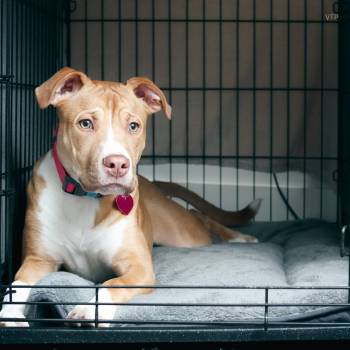
I do think that a crate for a puppy is appropriate for their safety and your home’s safety. But, I feel the goal is to raise a dog that is house-happy, that can be left on its own without incident and can be trusted. But, let’s see what the other opinions include.
In terms of puppies, it is a good idea to have some kind of confinement to make sure they do not get into something harmful. Puppy-proofing a house is a must and you can access all the puppy-proofing tips in my episode on “Yeah! you’re getting a new puppy.” The problem with crating a puppy lies in some basic physiology.
A puppy under 6 months should only be in a crate for 3 to 4 hours. Their bladder and bowels are just not developed enough to be able to hold a pee or poo longer than a few hours. But, think about it. How many new puppy owners have you encountered that crate their puppy overnight? Well, that is much longer than 3 or 4 hours. So, to not force a puppy to mess in its crate, you will have to set an alarm and get up in the middle of the night and take it out.
Unfortunately, too many people have been following the crate your puppy rule and by doing it all night without relief for the puppy. I get asked fairly regularly about putting puppy pads in the crate overnight so the puppy can go on the pad. This means to me, they are not making the effort to let the puppy out in the middle of the night.
I also have had people say that when they put the puppy in the crate it will cry for hours. What!? This means these people have left the puppy in the crate crying for hours. A puppy should never be left in a crate crying, especially when it is new to the home. The idea that the crate is supposed to be a safe place is far from being introduced if the puppy is feeling insecure, afraid and lonely. It’s possible that a crate may not be the containment option for this puppy. In this case, I would look into an exercise pen. This will contain the puppy but have them feel less confined.
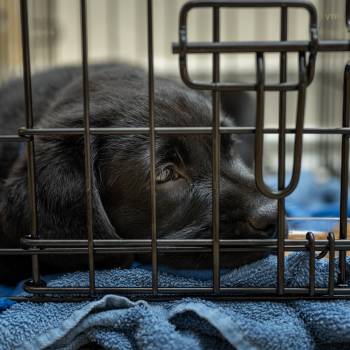
As the dog ages, it can stay in its crate longer. But, I know people that put their dog in the crate, leave for work, return 9 or 10 hours later and then let the dog out. Yes, the dog goes for a walk and a play, but it has been crated for a very long time. In this type of situation, where the dog cannot be trusted in the house alone, I would strongly suggest a friend, neighbour, hired dog caregiver, or whomever, be enlisted to go into your home and take the dog out halfway through the day.
There are quite a few pros and cons to using a crate. As I’ve said, it is a tool that can be used with a new puppy. As the dog ages, decisions will need to be made. I just advise that using a crate is not a rule. The dog’s well-being has to be at the forefront. Some dogs are totally fine with their crate and enjoy them. Some dogs hate their crate. I suggest being flexible when it comes to their use.
So, should you crate your dog? And should a dog be crated its entire life? I’m going to say, this is not a “should” this is a matter of the dog’s preference and ability to become house friendly, with parents that can be flexible to the dog’s personality.
Well, there you have it. My top five selection of “should I” questions. And just like with cats, the most important “should” is, that you should care for your dog, love your dog and fix your dog. Those are the most important “should” to begin with. After that, hopefully, I have given some helpful tips for some of the other “should I” questions, but as always you “should” be doing some research because as I say, knowing is caring.

Tagged as: Should my dog’s nose be wet or dry, Should my dog’s paws be rough, Should my dog sleep in a crate, Should my dog have a raised bowl, Should my dog be eating grass.
Hi everyone, and welcome to Val Talk’s Pets, the forum for pet parents and enthusiasts alike. So, I have been working in the pet industry now for almost 10 years and, on a daily basis, I handle a lot of issues and questions arising from pet parents. I am not a veterinarian but I do have certifications in Canine, Feline, Small Animal, Fish and Herptile and Avian Health and Nutrition from the University of California, Davis Extension, the Vet College.

Val Cairney September 20, 2024
Hi everyone, and thanks for joining me on this edition of Val Talk’s Pets. In this edition, I am going to talk about fall allergies. The rise in pet parents […]

Val Cairney September 20, 2024

Val Cairney July 12, 2024
For the price of a coffee, or more if you are feeling generous, you can help keep this podcast going & growing. Please visit my ko-fi page to make a donation. Thanks!
all rights reserved - Val Talks Pets - 2024